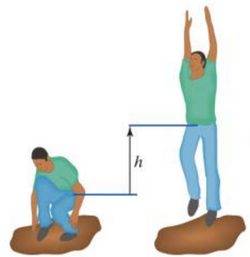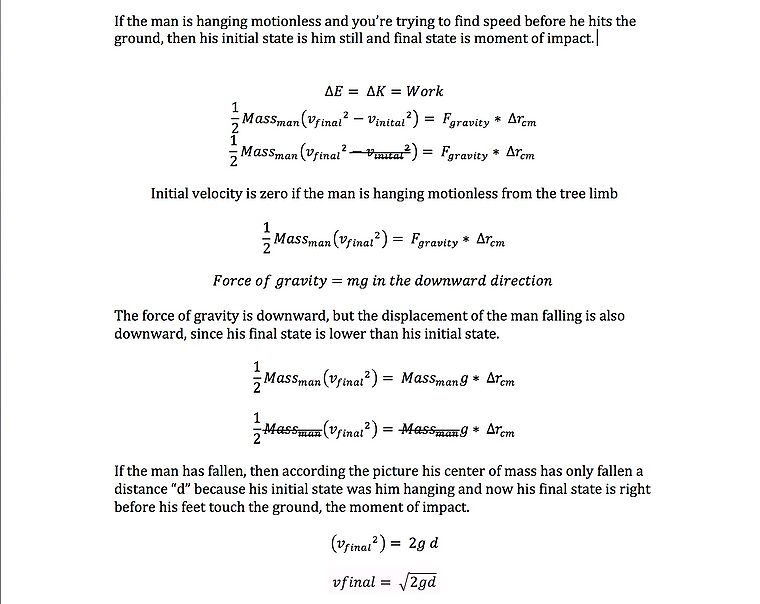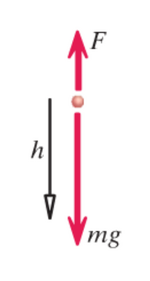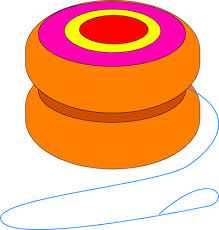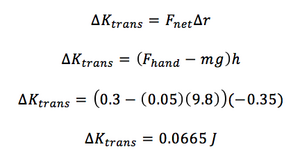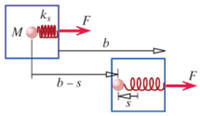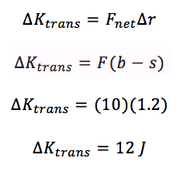Point Particle Systems: Difference between revisions
| Line 23: | Line 23: | ||
<p style="margin-left:4%;">Next, let us consider the gravitational potential energy of an object near the surface of the earth (<math>U = mgh</math>). No matter what point on the object is chosen to represent it, if the object falls a certain distance, that point's height will change by a set amount, so the change in the object's gravitational potential energy is the same. The potential energy of an object due to a uniform force field can be accurately calculated by treating it as a point.</p> | <p style="margin-left:4%;">Next, let us consider the gravitational potential energy of an object near the surface of the earth (<math>U = mgh</math>). No matter what point on the object is chosen to represent it, if the object falls a certain distance, that point's height will change by a set amount, so the change in the object's gravitational potential energy is the same. The potential energy of an object due to a uniform force field can be accurately calculated by treating it as a point.</p> | ||
<p style="margin-left:4%;">Finally, let us consider the gravitational potential energy of an object in space near earth (<math>U = -\frac{GM_{earth}m}{r}</math>). In this case, the point on the object chosen to represent it actually does affect the change in potential energy it experiences for a given movement because of the nonlinear nature of the potential energy function. Only one choice of point, known as the object's center of gravity, yields the correct potential energy. However, even for an object as large as the moon, the diameter of the object is usually very small compared to the distance over which the potential energy significantly change. This means that minimal error is introduced by using an arbitrary point to represent the entire moon, particularly if the center of mass is used, which is normally near the center of gravity.</p> | <p style="margin-left:4%;">Finally, let us consider the gravitational potential energy of an object in space near earth (<math>U = -\frac{GM_{earth}m}{r}</math>). In this case, the point on the object chosen to represent it actually does affect the change in potential energy it experiences for a given movement because of the nonlinear nature of the potential energy function. Only one choice of point, known as the object's center of gravity, yields the correct potential energy. However, even for an object as large as the moon, the diameter of the object is usually very small compared to the distance over which the potential energy significantly change. This means that minimal error is introduced by using an arbitrary point to represent the entire moon, particularly if the center of mass is used, which is normally near the center of gravity. The potential energy of other radial forces like the electric force works the same way.</p> | ||
==Examples== | ==Examples== | ||
Revision as of 15:14, 8 June 2019
This page describes the model in which systems are represented as point particles.
The Main Idea
A point particle system is a physical system in which each multidimensional rigid body of matter is modeled as a particle that exists at a single point in space. In such a model, a point somewhere on the body is chosen to represent the entire body. Often, this point is its center of mass. The geometry of the body, including the spatial distribution of its mass, is ignored. Point particle systems are in contrast to Real Systems, which respect the geometry of bodies of matter.
Point particle systems are used to represent certain types of systems because they simplify some of the math involved in analyzing their motion. That said, only certain aspects of a system's motion can be accurately modeled if it is treated as a point mass system. For example, a particle's translational Acceleration can be accurately found using the forces acting on the particle along with the particle's mass. However, the rotation of an object cannot be modeled if it is treated as a single point. This is because it is meaningless to describe a point as "rotating" since it has no geometry. The mathematical model section describes in more detail what point particle systems can and cannot model.
Although you may not have been aware of it, you have been modeling systems as point particle systems for most of the problems in this course so far. For example, consider a problem where a ball is thrown from a known position with a known initial velocity, and you are asked to find quantities such as the highest point in its trajectory and the horizontal distance it has traveled when it hits the ground. You would perform calculations as though the ball has a single position vector at any point in time, even though it is actually a 3D object that takes up a volume. This is acceptable because the diameter of the ball is much smaller than the distances involved in its trajectory and because the problem is not concerned with the rotation of the ball.
A Mathematical Model
What aspects of a system's motion can be accurately calculated if it is reduced to a point particle?
If an object is modeled as a point particle, the forces acting on it can be used along with the particle's mass to accurately find its the translational Acceleration ([math]\displaystyle{ \vec{a} = \frac{\vec{F}_{net}}{m} }[/math]). This is because the geometry of the object doesn't affect its acceleration; it doesn't matter what part of the object the forces act on for the purpose of finding acceleration.
The Linear Momentum ([math]\displaystyle{ \vec{p} = m \vec{v} }[/math]) and translational Kinetic Energy ([math]\displaystyle{ KE = \frac{1}{2} m v^2 }[/math]) an object can also be correctly calculated if the object is represented as a single point; the formulas simply use the mass and velocity of that point.
Finally, the potential energy of an object, which is a function of its position, can usually be found with little to no error if the object is treated as a single point. There are several types of potential energy.
Let us first consider the elastic potential energy of an object attached to a spring ([math]\displaystyle{ U = \frac{1}{2} k x^2 }[/math]). No matter what point on the object is chosen to represent it, that point has an equilibrium position, and that point's displacement from the equilibrium position is equal to the amount by which the spring is stretched, which can be used to find its potential energy. The reduction of the object to a point does not introduce error.
Next, let us consider the gravitational potential energy of an object near the surface of the earth ([math]\displaystyle{ U = mgh }[/math]). No matter what point on the object is chosen to represent it, if the object falls a certain distance, that point's height will change by a set amount, so the change in the object's gravitational potential energy is the same. The potential energy of an object due to a uniform force field can be accurately calculated by treating it as a point.
Finally, let us consider the gravitational potential energy of an object in space near earth ([math]\displaystyle{ U = -\frac{GM_{earth}m}{r} }[/math]). In this case, the point on the object chosen to represent it actually does affect the change in potential energy it experiences for a given movement because of the nonlinear nature of the potential energy function. Only one choice of point, known as the object's center of gravity, yields the correct potential energy. However, even for an object as large as the moon, the diameter of the object is usually very small compared to the distance over which the potential energy significantly change. This means that minimal error is introduced by using an arbitrary point to represent the entire moon, particularly if the center of mass is used, which is normally near the center of gravity. The potential energy of other radial forces like the electric force works the same way.
Examples
Jumper Model
A person jumps straight up in the air from a crouching position. Their center of mass moves h, or 2 m. Their total mass, m is equal to 60 kg. Find the velocity of the center of mass of the jumper. When the jumper jumps, the normal force of the ground is equal to 2x the force of gravity.
To make this problem simpler, use the center of mass of the person to collapse the whole system to one point.
Imagine the jumper's center of mass as a point, and it moves up 2 m.
Remember, ![]() ,
, ![]() and
and ![]() .
We need to find Fnet. The only forces acting on the jumper are the gravitational force of the Earth and the normal force. Therefore,
.
We need to find Fnet. The only forces acting on the jumper are the gravitational force of the Earth and the normal force. Therefore,

Steps:
Notice that the initial translational kinetic energy is 0, as the person is initially at rest. When worked out, the v = 6.26 m/s.
The final translational kinetic energy can be used for further calculations if one was to calculate the total change in energy of the real system. These calculations would allow you to find the change in various forms of internal energy, such as heat energy or chemical energy.
Another example that the point particle system can be applied to is someone hanging motion-less and then jumping down into a crouch position.
Looking at the system as a point particle system, you can look at the initial and final states of the man in order to find the change in energy. We are going to again use a formula for work, ![]()
In order to find the speed just before your feet touch the ground, you can set an equation as the following:
The equation for the point particle system ∆E= ∆K=Work can be applied in order to find different variables asked for in a problem.
Remember that if the man does not move, then the work done by the man will be 0 joules, because there is no displacement.
Yo-Yo Example
You pull up on a string the distance d, 0.2 m, with a force, F, 0.3 N. The yo-yo falls a distance h, 0.35 m. The mass of the yo-yo, m, is 0.05 kg. What is the change in translational kinetic energy?
For this example, the Fnet is equal to the force of your hand and the gravitational force of the earth. Delta r is equal to the movement of the yo-yo down, h.
Steps:
This information could be used to solve for the extended system, which would include the work done by your hand and the earth, as well as rotational kinetic energy.
Spring in a Box Example
Suppose a thin box contains a ball of clay with the mass M, 2 kg, connected to a relaxed spring, with a stiffness ks, 1.2. The masses of the box and the spring are negligible. It is initally at rest, and then a constant force of F, or 10 N. The box moves a distance b, 1.5 m, and the spring stretches a distance s, 0.3 m, so that the clay sticks to the box. What is the translational kinetic energy of the box?
For the point particle system, the center of mass is the clay because the other masses are negligible. Therefore, delta r is equal to b-s, or 1.2 m. The only force acting on is F in the +x direction.
Steps:
This information could then be used for the extended system. In this example, the extended system would also include the work done by the force F, the potential energy of the spring,as well as any other internal energies.
Connectedness
- How is this topic connected to something that you are interested in?
I find the entire realm of physics fascinating, and I find it interesting how physicists are constantly coming up with new ways to solve problems and use formulas. The point particle system is a perfect example of that. It can turn a complicated force problem into something easy to approve. I also find it interesting how you can find other forms of energy, such as chemical energy, by using point particle and real systems. Something so small and seemingly unattainable can be found using this method.
- How is it connected to your major?
I am majoring in Materials Science and Engineering, and there are many ways all different types of physics can be used in MSE. The engineering of materials, specifically being able to calculate the amount and types of energy (and thus the cost) to produce something is absolutely crucial. Point particle systems can make this easier to do, while also adding precision to the calculations.
- An interesting industrial application
As seen in the above examples, there are many real life applications to point particle systems, such as the energy in a person falling, or in a yoyo. This system can also be applied to industry and manufacturing, with the use of various machines that may require gears, levers, or other objects that rotate. Using point particle and real systems, you can calculate the amount of internal energy happening in a moving machine, and therefore how much energy is lost.
See also
Further reading
For more help, a helpful page is: http://p3server.pa.msu.edu/coursewiki/doku.php?id=183_notes:pp_vs_real
A helpful video lecture: https://www.youtube.com/watch?v=T780lL5FlLg&index=41&list=PL9HgJKLOnKxedh-yIp7FDzUTwZeTeoR-Y
External links
See also Real Systems for further information on using Point Particle Systems to solve for the Real Systems.
References
Chabay, Ruth W., and Bruce A. Sherwood. "9." Matter & Interactions. N.p.: n.p., n.d. N. pag. Print.
Purdue Physics. https://www.physics.purdue.edu/webapps/index.php/course_document/index/phys172/1160/42/5399.
Yo-yo Clipart: https://www.clipartbest.com
